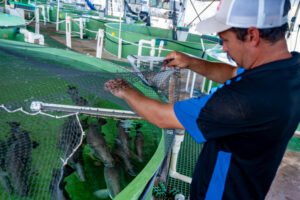Thursday, 18 December 2025
A toast to transformation: Vinarchy’s roadmap to wine industry leadership
Sean Cunial, Regional Managing Director for Asia at Vinarchy In a significant development for the global wine industry, Accolade Wines and Pernod Ricard have merged their wine assets to create…

Sean Cunial, Regional Managing Director for Asia at Vinarchy
In a significant development for the global wine industry, Accolade Wines and Pernod Ricard have merged their wine assets to create Vinarchy. This bold new venture unites iconic brands such as Hardys, Campo Viejo, and Jacob’s Creek under a single identity. The name ‘Vinarchy,’ which combines ‘vin’ (French for wine) and ‘archy’ (meaning leadership), reflects the company’s ambition to lead the next chapter of the global wine narrative through innovation, sustainability, and a strong focus on consumers.
In an exclusive interview with NUFFOODS Spectrum, Sean Cunial, Regional Managing Director for Asia at Vinarchy, discusses the vision behind the merger. He explains how the company plans to evolve in key markets, including Asia and North America, while balancing the legacy of its brands with forward-thinking strategies. Cunial provides a comprehensive overview of Vinarchy’s goals for sustainability, digital engagement strategies, and the integration of its internal culture, outlining how the company aims to reshape the wine industry for the next generation of consumers.
What was the strategic vision that led to the merger of Accolade Wines and Pernod Ricard’s wine assets to create Vinarchy?
The strategic vision behind the merger was to create a focused, globally scaled wine business with the capability to lead the category into its next era. By bringing together the global operations of Accolade Wines and Pernod Ricard’s Australian, New Zealand and Spanish wine assets, we’ve combined the best of these historic wine businesses.
We felt it was important to unify the new company under a new name and identity. Vin references wine, and Archy comes from the word that means leadership in Ancient Greek.
In short, it means wine leadership and reflects our mission to redefine wine through innovation.
How do you envision Vinarchy’s position evolving within the global wine market over the next 5–10 years?
It’s early days and we are still forming our global strategy, but with 11 wineries across four countries and sourcing from world-class regions like Italy, Argentina, France, the U.S. and Chile, Vinarchy has the scale and flexibility to respond to evolving consumer needs.
We’ll keep building on that strength by growing our footprint in key markets and investing in innovation that helps us better serve more customers in more markets around the world.
Vinarchy now oversees a significant portfolio of well-known brands, including Hardys, Campo Viejo, and Jacob’s Creek. What is your approach to balancing the heritage of these brands with the need for innovation under the new Vinarchy identity?
Our portfolio includes some of the world’s most recognised and trusted wine brands – each with a distinct history and loyal following. We’re proud of that heritage, and we also understand the world of wine is changing. Our focus is on preserving what makes these brands so special and unique, while continuing to evolve through sustainable formats, refreshed packaging and new styles and experiences. We’re passionate about building brands that are bold and relevant for today’s wine drinkers.
With a substantial production volume across four continents, what specific sustainability goals and initiatives will Vinarchy be implementing throughout its wineries and supply chain?
Sustainability is core to how we operate, and we’re focused on reducing our footprint while creating long-term value for our people, partners and local communities. We will be building on existing programs, with a focus on reducing emissions, conserving water, advancing circular packaging and increasing biodiversity and soil health.
We take pride in the sustainability initiatives we’ve implemented, such as harnessing geothermal and solar energy at our Campo Viejo winery in Spain, investing in wetlands management and planting native windbreaks to enhance vine health and local biodiversity.
What are Vinarchy’s plans for enhancing its global distribution and retail presence, especially within key growth regions such as Asia and North America?
Asia and North America are key focus areas for Vinarchy. In Asia, we’re already the #1 still wine supplier by volume, with Jacob’s Creek leading as the top Australian wine brand and the most popular international wine in India.
In North America, Jacob’s Creek is the top imported wine in Canada, and we’re gaining strong traction with innovative brands like Dolly Wines in the U.S., which has rapidly secured national distribution.
We’re focused on refining our route-to-market strategies and evolving our offer to match the pace of local consumer expectations.
Considering the consolidation of two major wine portfolios, how is Vinarchy addressing internal cultural integration and ensuring talent retention among its 1,600 employees?
Bringing together two businesses is as much about people as it is about brands. From the outset, we’ve focused on supporting employees through the change and making sure they feel informed, heard and part of shaping what comes next.
We’re building a culture that reflects the strengths of both legacy businesses while creating something new that people are proud to be part of. It’s early days, but feedback so far has been positive, and we’ll keep adapting and investing in our people as the business evolves.
What emphasis will Vinarchy place on premiumisation, digital marketing strategies, and direct-to-consumer channels as part of its overall growth strategy?
Vinarchy is proud to offer quality wines at every price point, from premium fine wines to everyday brands and each step in between. Premiumisation remains a key market trend, but for us, it’s about providing options for consumers to trade up at every level rather than centring solely on fine wine. Our approach will be driven by a focus on quality, innovation and connecting with our consumers in culturally relevant moments.
Digital marketing and its many channels are critical for us in creating meaningful connections with our consumers. We focus on data-led digital insights, social media engagement and are always searching for new consumer touchpoints to drive engagement and excitement.
Direct-to-consumer channels will continue to grow and consistently assist us to test, learn and build deeper connections for our brands and their consumers.
Shraddha Warde
shraddha.warde@mmactiv.com
Technology
Nfinite secures funding to scale up breakthrough paper packaging solution
Dec 17, 2025 | Company News
Silal–Square Roots partnership uses AI to boost sustainable food production
Dec 17, 2025 | Company News
Food Testing
Australia’s Humpty Doo Barramundi farm to achieve ASC certification
Dec 08, 2025 | Australia
SFDA and Turkish Halal Accreditation Agency forge strategic partnership
Dec 05, 2025 | Food
Fish freshness easily monitored with a new sensor
Dec 04, 2025 | Food Safety and Testing
More Popular
Nfinite secures funding to scale up breakthrough paper packaging solution
Dec 17, 2025 | Company News
Silal–Square Roots partnership uses AI to boost sustainable food production
Dec 17, 2025 | Company News
Korea's Samson Food broadens seafood portfolio with hwangto salt-based products
Dec 17, 2025 | Company News






